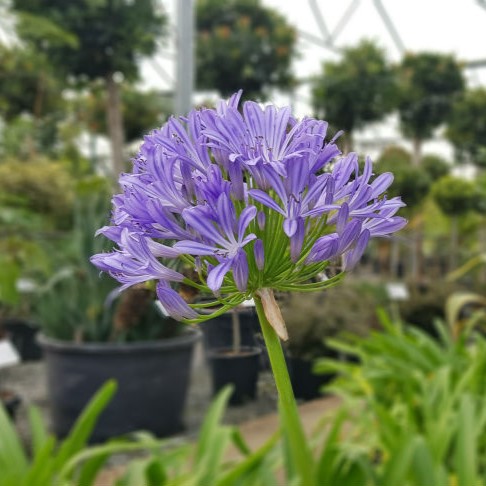Agapanthus Varieties: Choosing the Best for Your Landscape
Agapanthus Varieties: Choosing the Best for Your Landscape
Blog Article
Grasping the Art of Agapanthus Care: Necessary Actions for Healthy And Balanced Growth and Dynamic Blossoms
In the realm of gardening, the growing of agapanthus stands as a fulfilling endeavor for those who look for to support these elegant blooming plants. From selecting the right range to grasping trimming strategies, the journey in the direction of cultivating flourishing agapanthus plants is multifaceted and holds the key to unlocking the full potential of these botanical treasures.

Choosing the Right Agapanthus Variety

When choosing the appropriate Agapanthus variety for your garden, take into consideration factors such as climate viability, bloom color, and development behavior. Agapanthus, typically referred to as Lily of the Nile or African lily, is available in a selection of shades ranging from shades of purple and blue to white. Choose a bloom color that enhances your existing yard scheme to create an unified landscape. In addition, take into consideration the environment in your area to ensure the Agapanthus selection you select can flourish in your certain problems. Some ranges are extra forgiving of chilly temperature levels, while others like warmer environments. Understanding the development practice of different Agapanthus ranges is important for appropriate positioning within your garden. Some ranges have a clumping development behavior, suitable for containers or borders, while others have an even more dispersing nature, ideal for ground cover or mass plantings. By carefully evaluating these elements, you can pick the ideal Agapanthus variety to boost the elegance of your garden.
Suitable Growing Problems
Taking into consideration the ideal ecological requirements is vital for effective Agapanthus growing. Agapanthus plants are delicate to cold temperatures and must be protected from frost during wintertime months.
To make certain healthy development and dynamic flowers, plant Agapanthus light bulbs at a deepness of concerning 2-4 inches and room them 8-12 inches apart. Mulching around the base of the plants aids preserve wetness and reduces weed development.
Watering and Feeding Tips
Preserving appropriate wetness degrees and supplying vital nutrients are crucial aspects in the care regimen for Agapanthus plants. When it comes to watering Agapanthus, it is important to strike a balance. If overwatered, these plants prefer continually wet soil but are susceptible to root rot. Throughout the expanding period, water deeply as soon as a week, making sure the soil is well-draining to stop waterlogging. In hotter climates or throughout durations of dry spell, more frequent watering may be needed to keep the soil equally damp. However, reduce watering in see this website the winter season to stop waterlogged problems.
Feeding Agapanthus is necessary for advertising healthy development and prolific blossoms. Apply a balanced plant food, such as a 10-10-10 formula, in the early spring as brand-new development arises. Repeat this application every 6-8 weeks throughout the expanding period. Avoid too much fertilizing, as it can cause rich foliage at the expense of blossoms. Always adhere to the maker's instructions for proper dilution and application approaches. By following these watering and feeding ideas, you can guarantee your Agapanthus plants grow and produce dynamic, resilient blooms.
Pruning Methods for Agapanthus
Pruning Agapanthus navigate to this website plants at the ideal times and with appropriate techniques is critical for maintaining their wellness and promoting ideal growth and flowering. The excellent time to trim Agapanthus remains in late winter season or early right here spring before brand-new development emerges. Beginning by getting rid of any yellowing or dead leaves near the base of the plant. Cut them as close to the ground as possible without damaging the emerging shoots.
Deadheading spent blossoms can likewise reroute the plant's power right into producing more flowers rather than establishing seeds. If you desire to collect seeds for proliferation, leave some blossoms to completely dry and fully grown on the plant.
Keep in mind to utilize clean, sharp tools to make accurate cuts and decrease the danger of introducing conditions. Agapanthus. Routine pruning will assist maintain your Agapanthus looking neat and healthy while guaranteeing an abundant display screen of gorgeous blossoms
Dealing With Typical Pests and Diseases
After ensuring correct trimming techniques for Agapanthus, it is necessary to resolve typical insects and conditions that can impact the health and vitality of these plants. One common parasite that influences Agapanthus is the Agapanthus gall midge.
Additionally, Agapanthus plants can endure from root rot if they are planted in poorly draining soil. By being cautious and taking timely activity versus diseases and pests, you can aid your Agapanthus plants prosper and create vibrant blossoms. Agapanthus.

Conclusion
To conclude, grasping the art of agapanthus care involves selecting the ideal range, giving ideal planting conditions, correct watering and fertilizing, proper trimming techniques, and resolving common pests and conditions. By adhering to these essential actions, you can ensure healthy and balanced growth and vibrant blooms for your agapanthus plants. Bear in mind to frequently keep track of and preserve your plants to promote their general well-being and longevity.
To ensure healthy and balanced growth and lively flowers, plant Agapanthus light bulbs at a depth of regarding 2-4 inches and space them 8-12 inches apart. By complying with these watering and feeding pointers, you can ensure your Agapanthus plants flourish and produce dynamic, long-lasting flowers.
One usual insect that affects Agapanthus is the Agapanthus gall midget. Additionally, Agapanthus plants can experience from origin rot if they are grown in inadequately draining pipes soil. By complying with these crucial actions, you can make certain healthy and balanced growth and lively flowers for your agapanthus plants.
Report this page